7.5: The Silicon-Controlled Rectifier (SCR)
- Page ID
- 774
\( \newcommand{\vecs}[1]{\overset { \scriptstyle \rightharpoonup} {\mathbf{#1}} } \)
\( \newcommand{\vecd}[1]{\overset{-\!-\!\rightharpoonup}{\vphantom{a}\smash {#1}}} \)
\( \newcommand{\id}{\mathrm{id}}\) \( \newcommand{\Span}{\mathrm{span}}\)
( \newcommand{\kernel}{\mathrm{null}\,}\) \( \newcommand{\range}{\mathrm{range}\,}\)
\( \newcommand{\RealPart}{\mathrm{Re}}\) \( \newcommand{\ImaginaryPart}{\mathrm{Im}}\)
\( \newcommand{\Argument}{\mathrm{Arg}}\) \( \newcommand{\norm}[1]{\| #1 \|}\)
\( \newcommand{\inner}[2]{\langle #1, #2 \rangle}\)
\( \newcommand{\Span}{\mathrm{span}}\)
\( \newcommand{\id}{\mathrm{id}}\)
\( \newcommand{\Span}{\mathrm{span}}\)
\( \newcommand{\kernel}{\mathrm{null}\,}\)
\( \newcommand{\range}{\mathrm{range}\,}\)
\( \newcommand{\RealPart}{\mathrm{Re}}\)
\( \newcommand{\ImaginaryPart}{\mathrm{Im}}\)
\( \newcommand{\Argument}{\mathrm{Arg}}\)
\( \newcommand{\norm}[1]{\| #1 \|}\)
\( \newcommand{\inner}[2]{\langle #1, #2 \rangle}\)
\( \newcommand{\Span}{\mathrm{span}}\) \( \newcommand{\AA}{\unicode[.8,0]{x212B}}\)
\( \newcommand{\vectorA}[1]{\vec{#1}} % arrow\)
\( \newcommand{\vectorAt}[1]{\vec{\text{#1}}} % arrow\)
\( \newcommand{\vectorB}[1]{\overset { \scriptstyle \rightharpoonup} {\mathbf{#1}} } \)
\( \newcommand{\vectorC}[1]{\textbf{#1}} \)
\( \newcommand{\vectorD}[1]{\overrightarrow{#1}} \)
\( \newcommand{\vectorDt}[1]{\overrightarrow{\text{#1}}} \)
\( \newcommand{\vectE}[1]{\overset{-\!-\!\rightharpoonup}{\vphantom{a}\smash{\mathbf {#1}}}} \)
\( \newcommand{\vecs}[1]{\overset { \scriptstyle \rightharpoonup} {\mathbf{#1}} } \)
\( \newcommand{\vecd}[1]{\overset{-\!-\!\rightharpoonup}{\vphantom{a}\smash {#1}}} \)
\(\newcommand{\avec}{\mathbf a}\) \(\newcommand{\bvec}{\mathbf b}\) \(\newcommand{\cvec}{\mathbf c}\) \(\newcommand{\dvec}{\mathbf d}\) \(\newcommand{\dtil}{\widetilde{\mathbf d}}\) \(\newcommand{\evec}{\mathbf e}\) \(\newcommand{\fvec}{\mathbf f}\) \(\newcommand{\nvec}{\mathbf n}\) \(\newcommand{\pvec}{\mathbf p}\) \(\newcommand{\qvec}{\mathbf q}\) \(\newcommand{\svec}{\mathbf s}\) \(\newcommand{\tvec}{\mathbf t}\) \(\newcommand{\uvec}{\mathbf u}\) \(\newcommand{\vvec}{\mathbf v}\) \(\newcommand{\wvec}{\mathbf w}\) \(\newcommand{\xvec}{\mathbf x}\) \(\newcommand{\yvec}{\mathbf y}\) \(\newcommand{\zvec}{\mathbf z}\) \(\newcommand{\rvec}{\mathbf r}\) \(\newcommand{\mvec}{\mathbf m}\) \(\newcommand{\zerovec}{\mathbf 0}\) \(\newcommand{\onevec}{\mathbf 1}\) \(\newcommand{\real}{\mathbb R}\) \(\newcommand{\twovec}[2]{\left[\begin{array}{r}#1 \\ #2 \end{array}\right]}\) \(\newcommand{\ctwovec}[2]{\left[\begin{array}{c}#1 \\ #2 \end{array}\right]}\) \(\newcommand{\threevec}[3]{\left[\begin{array}{r}#1 \\ #2 \\ #3 \end{array}\right]}\) \(\newcommand{\cthreevec}[3]{\left[\begin{array}{c}#1 \\ #2 \\ #3 \end{array}\right]}\) \(\newcommand{\fourvec}[4]{\left[\begin{array}{r}#1 \\ #2 \\ #3 \\ #4 \end{array}\right]}\) \(\newcommand{\cfourvec}[4]{\left[\begin{array}{c}#1 \\ #2 \\ #3 \\ #4 \end{array}\right]}\) \(\newcommand{\fivevec}[5]{\left[\begin{array}{r}#1 \\ #2 \\ #3 \\ #4 \\ #5 \\ \end{array}\right]}\) \(\newcommand{\cfivevec}[5]{\left[\begin{array}{c}#1 \\ #2 \\ #3 \\ #4 \\ #5 \\ \end{array}\right]}\) \(\newcommand{\mattwo}[4]{\left[\begin{array}{rr}#1 \amp #2 \\ #3 \amp #4 \\ \end{array}\right]}\) \(\newcommand{\laspan}[1]{\text{Span}\{#1\}}\) \(\newcommand{\bcal}{\cal B}\) \(\newcommand{\ccal}{\cal C}\) \(\newcommand{\scal}{\cal S}\) \(\newcommand{\wcal}{\cal W}\) \(\newcommand{\ecal}{\cal E}\) \(\newcommand{\coords}[2]{\left\{#1\right\}_{#2}}\) \(\newcommand{\gray}[1]{\color{gray}{#1}}\) \(\newcommand{\lgray}[1]{\color{lightgray}{#1}}\) \(\newcommand{\rank}{\operatorname{rank}}\) \(\newcommand{\row}{\text{Row}}\) \(\newcommand{\col}{\text{Col}}\) \(\renewcommand{\row}{\text{Row}}\) \(\newcommand{\nul}{\text{Nul}}\) \(\newcommand{\var}{\text{Var}}\) \(\newcommand{\corr}{\text{corr}}\) \(\newcommand{\len}[1]{\left|#1\right|}\) \(\newcommand{\bbar}{\overline{\bvec}}\) \(\newcommand{\bhat}{\widehat{\bvec}}\) \(\newcommand{\bperp}{\bvec^\perp}\) \(\newcommand{\xhat}{\widehat{\xvec}}\) \(\newcommand{\vhat}{\widehat{\vvec}}\) \(\newcommand{\uhat}{\widehat{\uvec}}\) \(\newcommand{\what}{\widehat{\wvec}}\) \(\newcommand{\Sighat}{\widehat{\Sigma}}\) \(\newcommand{\lt}{<}\) \(\newcommand{\gt}{>}\) \(\newcommand{\amp}{&}\) \(\definecolor{fillinmathshade}{gray}{0.9}\)Shockley Diodes and Silicon Controlled Rectifiers (SCRs)
Shockley diodes are curious devices, but rather limited in application. Their usefulness may be expanded, however, by equipping them with another means of latching. In doing so, each becomes true amplifying devices (if only in an on/off mode), and we refer to these as silicon-controlled rectifiers or SCRs.
The progression from Shockley diode to SCR is achieved with one small addition, actually nothing more than a third wire connection to the existing PNPN structure: (Figure below)
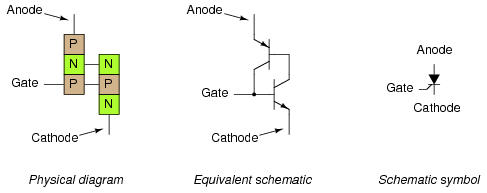
The Silicon-Controlled Rectifier (SCR)
SCR Conduction
If an SCR’s gate is left floating (disconnected), it behaves exactly as a Shockley diode. It may be latched by breakover voltage or by exceeding the critical rate of voltage rise between anode and cathode, just as with the Shockley diode. Dropout is accomplished by reducing current until one or both internal transistors fall into cutoff mode, also like the Shockley diode. However, because the gate terminal connects directly to the base of the lower transistor, it may be used as an alternative means to latch the SCR. By applying a small voltage between gate and cathode, the lower transistor will be forced on by the resulting base current, which will cause the upper transistor to conduct, which then supplies the lower transistor’s base with current so that it no longer needs to be activated by a gate voltage. The necessary gate current to initiate latch-up, of course, will be much lower than the current through the SCR from cathode to anode, so the SCR does achieve a measure of amplification.
Triggering/Firing
This method of securing SCR conduction is called triggering or firing, and it is by far the most common way that SCRs are latched in actual practice. In fact, SCRs are usually chosen so that their breakover voltage is far beyond the greatest voltage expected to be experienced from the power source so that it can be turned on only by an intentional voltage pulse applied to the gate.
Reverse Triggering
It should be mentioned that SCRs may sometimes be turned off by directly shorting their gate and cathode terminals together, or by “reverse-triggering” the gate with a negative voltage (in reference to the cathode), so that the lower transistor is forced into cutoff. I say this is “sometimes” possible because it involves shunting all of the upper transistor’s collector current past the lower transistor’s base. This current may be substantial, making triggered shut-off of an SCR difficult at best. A variation of the SCR, called a Gate-Turn-Off thyristor, or GTO, makes this task easier. But even with a GTO, the gate current required to turn it off may be as much as 20% of the anode (load) current! The schematic symbol for a GTO is shown in the following illustration: (Figure below)
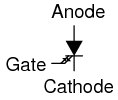
The Gate Turn-Off thyristor (GTO)
SCRs vs GTOs
SCRs and GTOs share the same equivalent schematics (two transistors connected in a positive-feedback fashion), the only differences being details of construction designed to grant the NPN transistor a greater β than the PNP. This allows a smaller gate current (forward or reverse) to exert a greater degree of control over conduction from cathode to anode, with the PNP transistor’s latched state being more dependent upon the NPN’s than vice versa. The Gate-Turn-Off thyristor is also known by the name of Gate-Controlled Switch, or GCS.
Testing SCR Functionality with an Ohmmeter
A rudimentary test of SCR function, or at least terminal identification, may be performed with an ohmmeter. Because the internal connection between gate and cathode is a single PN junction, a meter should indicate continuity between these terminals with the red test lead on the gate and the black test lead on the cathode like this: (Figure below)
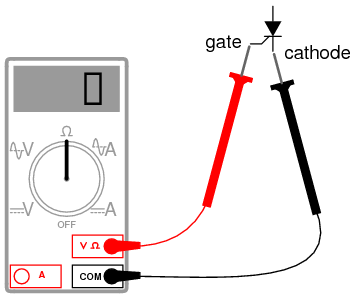
Rudimentary test of SCR
All other continuity measurements performed on an SCR will show “open” (“OL” on some digital multimeter displays). It must be understood that this test is very crude and does not constitute a comprehensive assessment of the SCR. It is possible for an SCR to give good ohmmeter indications and still be defective. Ultimately, the only way to test an SCR is to subject it to a load current.
If you are using a multimeter with a “diode check” function, the gate-to-cathode junction voltage indication you get may or may not correspond to what’s expected of a silicon PN junction (approximately 0.7 volts). In some cases, you will read a much lower junction voltage: mere hundredths of a volt. This is due to an internal resistor connected between the gate and cathode incorporated within some SCRs. This resistor is added to make the SCR less susceptible to false triggering by spurious voltage spikes, from circuit “noise” or from static electric discharge. In other words, having a resistor connected across the gate-cathode junction requires that a strong triggering signal (substantial current) be applied to latch the SCR. This feature is often found in larger SCRs, not on small SCRs. Bare in mind that an SCR with an internal resistor connected between gate and cathode will indicate continuity in both directions between those two terminals: (Figure below)
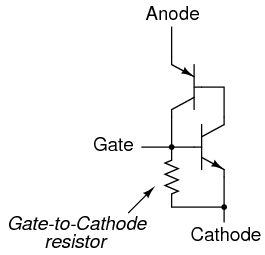
Larger SCRs have gate to cathode resistor.
Sensitive Gate SCRs
“Normal” SCRs, lacking this internal resistor, are sometimes referred to as sensitive gate SCRs due to their ability to be triggered by the slightest positive gate signal.
The test circuit for an SCR is both practical as a diagnostic tool for checking suspected SCRs and also an excellent aid to understanding basic SCR operation. A DC voltage source is used for powering the circuit, and two pushbutton switches are used to latch and unlatch the SCR, respectively: (Figure below)
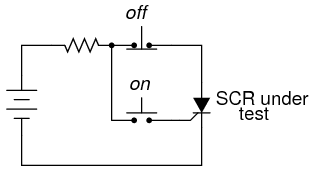
SCR testing circuit
Actuating the normally-open “on” pushbutton switch connects the gate to the anode, allowing current from the negative terminal of the battery, through the cathode-gate PN junction, through the switch, through the load resistor, and back to the battery. This gate current should force the SCR to latch on, allowing current to go directly from cathode to anode without further triggering through the gate. When the “on” pushbutton is released, the load should remain energized.
Pushing the normally-closed “off” pushbutton switch breaks the circuit, forcing current through the SCR to halt, thus forcing it to turn off (low-current dropout).
Holding Current
If the SCR fails to latch, the problem may be with the load and not the SCR. A certain minimum amount of load current is required to hold the SCR latched in the “on” state. This minimum current level is called the holding current. A load with too great a resistance value may not draw enough current to keep an SCR latched when gate current ceases, thus giving the false impression of a bad (unlatchable) SCR in the test circuit. Holding current values for different SCRs should be available from the manufacturers. Typical holding current values range from 1 milliamp to 50 milliamps or more for larger units.
For the test to be fully comprehensive, more than the triggering action needs to be tested. The forward breakover voltage limit of the SCR could be tested by increasing the DC voltage supply (with no pushbuttons actuated) until the SCR latches all on its own. Beware that a breakover test may require very high voltage: many power SCRs have breakover voltage ratings of 600 volts or more! Also, if a pulse voltage generator is available, the critical rate of voltage rise for the SCR could be tested in the same way: subject it to pulsing supply voltages of different V/time rates with no pushbutton switches actuated and see when it latches.
In this simple form, the SCR test circuit could suffice as a start/stop control circuit for a DC motor, lamp, or other practical load: (Figure below)
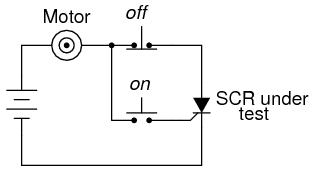
DC motor start/stop control circuit
The “Crowbar” Circuit
Another practical use for the SCR in a DC circuit is as a crowbar device for overvoltage protection. A “crowbar” circuit consists of an SCR placed in parallel with the output of a DC power supply, for placing a direct short-circuit on the output of that supply to prevent excessive voltage from reaching the load. Damage to the SCR and power supply is prevented by the judicious placement of a fuse or substantial series resistance ahead of the SCR to limit short-circuit current: (Figure below)
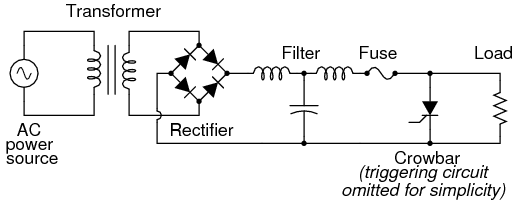
Crowbar circuit used in DC power supply
Some device or circuit sensing the output voltage will be connected to the gate of the SCR, so that when an overvoltage condition occurs, voltage will be applied between the gate and cathode, triggering the SCR and forcing the fuse to blow. The effect will be approximately the same as dropping a solid steel crowbar directly across the output terminals of the power supply, hence the name of the circuit.
Most applications of the SCR are for AC power control, despite the fact that SCRs are inherently DC (unidirectional) devices. If bidirectional circuit current is required, multiple SCRs may be used, with one or more facing each direction to handle current through both half-cycles of the AC wave. The primary reason SCRs are used at all for AC power control applications is the unique response of a thyristor to an alternating current. As we saw, the thyratron tube (the electron tube version of the SCR) and the DIAC, a hysteretic device triggered on during a portion of an AC half-cycle will latch and remain on throughout the remainder of the half-cycle until the AC current decreases to zero, as it must to begin the next half-cycle. Just prior to the zero-crossover point of the current waveform, the thyristor will turn off due to insufficient current (this behavior is also known as natural commutation) and must be fired again during the next cycle. The result is a circuit current equivalent to a “chopped up” sine wave. For review, here is the graph of a DIAC’s response to an AC voltage whose peak exceeds the breakover voltage of the DIAC: (Figure below)
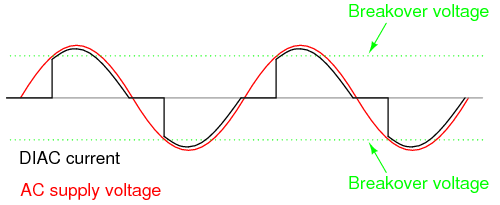.png?revision=1)
DIAC bidirectional response
With the DIAC, that breakover voltage limit was a fixed quantity. With the SCR, we have control over exactly when the device becomes latched by triggering the gate at any point in time along the waveform. By connecting a suitable control circuit to the gate of an SCR, we can “chop” the sine wave at any point to allow for time-proportioned power control to a load.
Take the circuit in Figure below as an example. Here, an SCR is positioned in a circuit to control power to a load from an AC source.
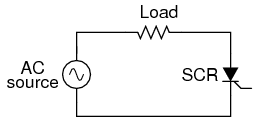
SCR control of AC power
Being a unidirectional (one-way) device, at most, we can only deliver half-wave power to the load, in the half-cycle of AC where the supply voltage polarity is positive on the top and negative on the bottom. However, for demonstrating the basic concept of time-proportional control, this simple circuit is better than one controlling full-wave power (which would require two SCRs).
With no triggering to the gate, and the AC source voltage well below the SCR’s breakover voltage rating, the SCR will never turn on. Connecting the SCR gate to the anode through a standard rectifying diode (to prevent reverse current through the gate in the event of the SCR containing a built-in gate-cathode resistor), will allow the SCR to be triggered almost immediately at the beginning of every positive half-cycle: (Figure below)
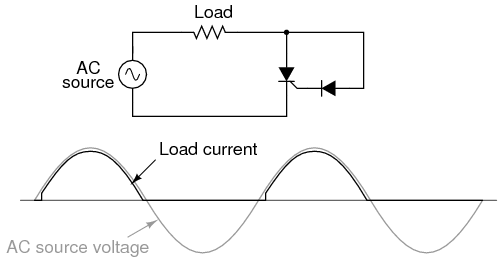
Gate connected directly to anode through a diode; nearly complete half-wave current through load.
SCR Trigger Delay
We can delay the triggering of the SCR, however, by inserting some resistance into the gate circuit, thus increasing the amount of voltage drop required before enough gate current triggers the SCR. In other words, if we make it harder for electrons to flow through the gate by adding a resistance, the AC voltage will have to reach a higher point in its cycle before there will be enough gate current to turn the SCR on. The result is in Figure below.
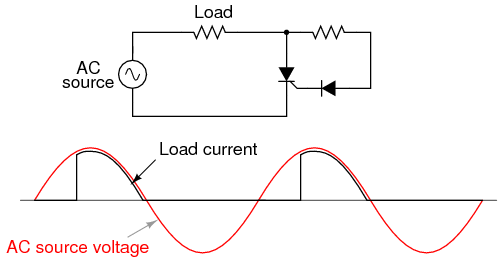
Resistance inserted in gate circuit; less than half-wave current through load.
With the half-sine wave chopped up to a greater degree by a delayed triggering of the SCR, the load receives less average power (power is delivered for less time throughout a cycle). By making the series gate resistor variable, we can make adjustments to the time-proportioned power: (Figure below)
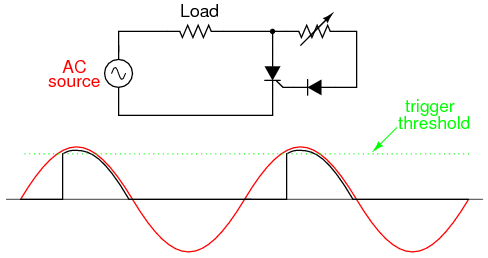
Increasing the resistance raises the threshold level, causing less power to be delivered to the load. Decreasing the resistance lowers the threshold level, causing more power to be delivered to the load.
Unfortunately, this control scheme has a significant limitation. In using the AC source waveform for our SCR triggering signal, we limit control to the first half of the waveform’s half-cycle. In other words, it is not possible for us to wait until after the wave’s peak to trigger the SCR. This means we can turn down the power only to the point where the SCR turns on at the very peak of the wave: (Figure below)
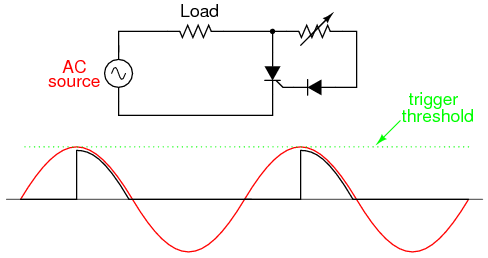
Circuit at minimum power setting
Raising the trigger threshold any more will cause the circuit to not trigger at all since not even the peak of the AC power voltage will be enough to trigger the SCR. The result will be no power to the load.
An ingenious solution to this control dilemma is found in the addition of a phase-shifting capacitor to the circuit: (Figure below)
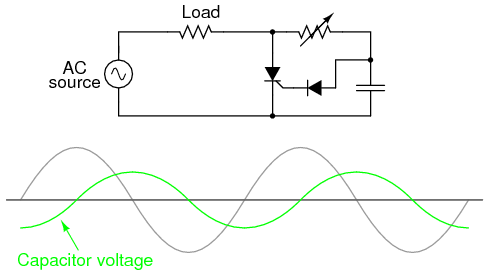
Addition of a phase-shifting capacitor to the circuit
The smaller waveform shown on the graph is the voltage across the capacitor. For the sake of illustrating the phase shift, I’m assuming a condition of maximum control resistance where the SCR is not triggering at all with no load current, save for what little current goes through the control resistor and capacitor. This capacitor voltage will be phase-shifted anywhere from 0o to 90o lagging behind the power source AC waveform. When this phase-shifted voltage reaches a high enough level, the SCR will trigger.
With enough voltage across the capacitor to periodically trigger the SCR, the resulting load current waveform will look something like Figure below)
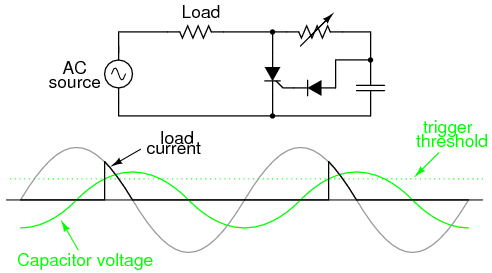
Phase-shifted signal triggers SCR into conduction.
Because the capacitor waveform is still rising after the main AC power waveform has reached its peak, it becomes possible to trigger the SCR at a threshold level beyond that peak, thus chopping the load current wave further than it was possible with the simpler circuit. In reality, the capacitor voltage waveform is a bit more complex than what is shown here, its sinusoidal shape distorted every time the SCR latches on. However, what I’m trying to illustrate here is the delayed triggering action gained with the phase-shifting RC network; thus, a simplified, undistorted waveform serves the purpose well.
SCR triggering by Complex Circuits
SCRs may also be triggered, or “fired,” by more complex circuits. While the circuit previously shown is sufficient for a simple application like a lamp control, large industrial motor controls often rely on more sophisticated triggering methods. Sometimes, pulse transformers are used to couple a triggering circuit to the gate and cathode of an SCR to provide electrical isolation between the triggering and power circuits: (Figure below)
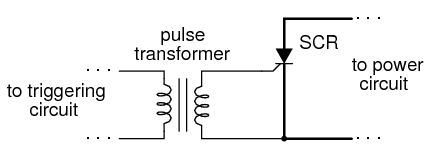
Transformer coupling of trigger signal provides isolation.
When multiple SCRs are used to control power, their cathodes are often not electrically common, making it difficult to connect a single triggering circuit to all SCRs equally. An example of this is the controlled bridge rectifier shown in Figure below.
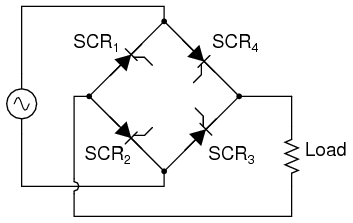
Controlled bridge rectifier
In any bridge rectifier circuit, the rectifying diodes (in this example, the rectifying SCRs) must conduct in opposite pairs. SCR1 and SCR3 must be fired simultaneously, and SCR2 and SCR4 must be fired together as a pair. As you will notice, though, these pairs of SCRs do not share the same cathode connections, meaning that it would not work to simply parallel their respective gate connections and connect a single voltage source to trigger both: (Figure below)
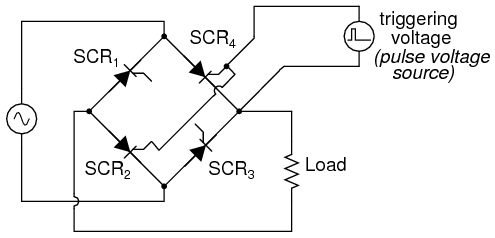
This strategy will not work for triggering SCR2 and SCR4 as a pair.
Although the triggering voltage source shown will trigger SCR4, it will not trigger SCR2 properly because the two thyristors do not share a common cathode connection to reference that triggering voltage. Pulse transformers connecting the two thyristor gates to a common triggering voltage source will work, however: (Figure below)
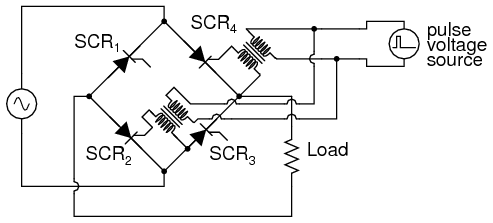
Transformer coupling of the gates allows triggering of SCR2 and SCR4 .
Bear in mind that this circuit only shows the gate connections for two out of the four SCRs. Pulse transformers and triggering sources for SCR1 and SCR3, as well as the details of the pulse sources themselves, have been omitted for the sake of simplicity.
Controlled bridge rectifiers are not limited to single-phase designs. In most industrial control systems, AC power is available in a three-phase form for maximum efficiency, and solid-state control circuits are built to take advantage of that. A three-phase controlled rectifier circuit built with SCRs, without pulse transformers or triggering circuitry shown, would look like Figure below.
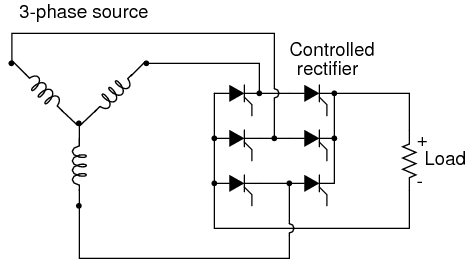
Three-phase bridge SCR control of load
REVIEW:
- A Silicon-Controlled Rectifier, or SCR, is essentially a Shockley diode with an extra terminal added. This extra terminal is called the gate, and it is used to trigger the device into conduction (latch it) by the application of a small voltage. To trigger, or fire, an SCR, voltage must be applied between the gate and cathode, positive to the gate and negative to the cathode.
- When testing an SCR, a momentary connection between the gate and anode is sufficient in polarity, intensity, and duration to trigger it. SCRs may be fired by an intentional triggering of the gate terminal, excessive voltage (breakdown) between anode and cathode, or an excessive rate of voltage rise between the anode and cathode. SCRs may be turned off by anode current falling below the holding current value (low-current dropout) or by “reverse-firing” the gate (applying a negative voltage to the gate). Reverse-firing is only sometimes effective and always involves high gate current.
- A variant of the SCR called a Gate-Turn-Off thyristor (GTO), is specifically designed to be turned off by means of reverse triggering. Even then, reverse triggering requires fairly high current: typically 20% of the anode current. SCR terminals may be identified by a continuity meter: the only two terminals showing any continuity between them at all should be the gate and cathode. Gate and cathode terminals connect to a PN junction inside the SCR, so a continuity meter should obtain a diode-like reading between these two terminals with the red (+) lead on the gate and the black (-) lead on the cathode. Beware, though, that some large SCRs have an internal resistor connected between gate and cathode, which will affect any continuity readings taken by a meter.
- SCRs are true rectifiers: they only allow current through them in one direction. This means they cannot be used alone for full-wave AC power control. If the diodes in a rectifier circuit are replaced by SCRs, you have the makings of a controlled rectifier circuit, whereby DC power to a load may be time-proportioned by triggering the SCRs at different points along the AC power waveform.


